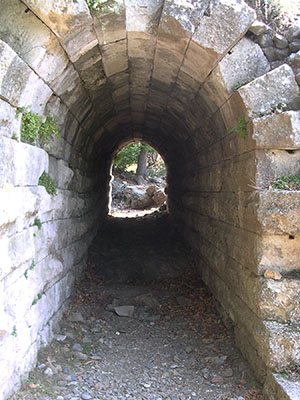|
|
 |
| My Favourite Planet > English > Europe > Greece > Northern Aegean > Samothraki > gallery |
 |
| Samothraki, Greece |
Samothraki gallery |
 |
 |
18 of 46 |
 |
 |
|
 |

Sanctuary of the Great Gods. Tunnel beneath
the Propylon of Ptolemy II, 3rd century BC. |
| |
The Propylon, also known as the Ptolemaion, was a monumental gateway to the Sanctuary of the Great Gods, built 285-281 BC by Ptolemy II Philadelphos (Πτολεμαῖος Φιλάδελφος, Ptolemy the sibling-loving, 309-246 BC), the Hellenistic pharoah of Egypt.

The roofed gatehouse was similar in form to a temple, built of large, regular blocks of Thasian marble [1], with hexastyle porches (i.e. supported by six columns) at each end: the columns on the outer (east) side of the gateway were Ionic, and those on the inner (west) side Corinthian. Above the side walls and porches ran a frieze of alternating bucrania (ox skulls) and rosettes. The decorative elements of the propylon were made of Proconnesian marble (from the island of Proconnesos, today Marmara, Turkey).

The building also functioned as a bridge, with the stone barrel-vaulted tunnel beneath it acting as a conduit for the eastern of two streams that flowed through the sanctuary. |
|
photo:
© David John |
|
| |
| Samothraki |
Notes, references and links |
 |
|

1. The marble of the Sanctuary of the Great Gods

Samples of stone from most of the monuments of the Sanctuary of the Great Gods were analysed in 2004 at the Laboratory of Archaeometry, Institute of Materials Science, NCSR "Demokritos", Aghia Paraskevi, Greece, using techniques of Measurement of Maximum Grain Size (MGS) under a stereoscopic microscope, Electron Paramagnetic Resonance Spectroscopy (EPR) and Stable Isotope Analysis (IRMS).

Most of the marble analysed was found to have come from the Aliki quarry of Thasos, Mount Penteli (Athens) and the island of Proconnesos (today Marmara, Turkey).

Only one sample, a fragment of a monumental left hand found on the Western Hill, was identified as being from Paros. The hand has been compared to that of the Winged Victory of Samothrace (see gallery page 8) which was sculpted from fine-grained, white marble from the Lakkoi Valley on Paros.

See:

Y. Maniatis, D. Tambakopoulos, E. Dotsika, B. D. Wescoat and D. Matsas, The Sanctuary of the Great Gods on Samothrace, Greece: an extended marble provenance study. In: Interdisciplinary studies on ancient stone. Proceedings of the IX ASMOSIA Conference (Tarragona 2009), pages 263-278, with illustrations and bibliography. Institut Català D'Arqueologia Clàssica, Tarragona, 2012.

The authors of the study came to the conclusion that coarse, greyish-white Thasian marble from Aliki was used for structural elements of monuments, such as blocks and column shafts and drums, while purer white Pentelic and Proconnesian marble were used for decorative elements, including column capitals and sculpture (friezes, akroteria). This may be have been partly in order to set off the decoration more dramatically, although as the authors point out, the monuments may have been painted. Exceptionally, some decorative elements, such as the long blocks of the frieze of the Hall of Choral Dancers (see gallery page 10) were made of Thasian marble, presumably because they also had a structural function.

Significantly, no pure white dolomitic marble from the Thasian Vathi-Saliara quarries was found in the monuments examined.

The use of Proconnesian marble at Samothraki, particularly in earlier monuments such as the Hall of Choral Dancers and the Propylon of Ptolemy II, was of special interest to scholars, as it confirms reports of ancient writers (Vitruvius, Pliny the Elder) that the island was exporting its marble more widely at an earlier period than had been previously assumed. The use of the marble became more widespread during the late Hellenistic and Roman Imperial periods (see Pergamon gallery 2, page 18). |
|
|
Photos, maps and articles: © David John,
except where otherwise specified.
All photos and articles are copyright protected.
Images and materials by other authors
have been attributed where applicable.
Please do not use these photos or articles without permission.
If you are interested in using any of the photos for your website,
project or publication, please get in contact.
Higher resolution versions are available on request.
Some of the information and photos in this guide to Samothraki
originally appeared in 2004 on davidjohnberlin.de.
My Favourite Planet makes great efforts to provide comprehensive and accurate information across this website. However, we can take no responsibility for inaccuracies or changes made by providers of services mentioned on these pages. |
|
| |
 |
Visit the My Favourite Planet Group on Facebook.

Join the group, write a message or comment,
post photos and videos, start a discussion... |
|
|
 |
|
|
| |
| |
 |
| |
 |
| |
 |
| |
 |
| |

George Alvanos

rooms
in Kavala's historic Panagia District

Anthemiou 35,
Kavala, Greece

kavalarooms.gr
 |
| |
|